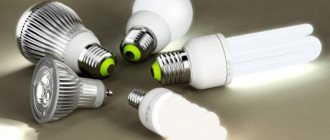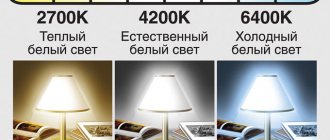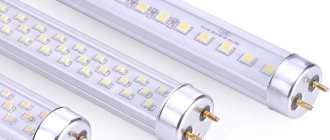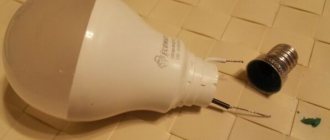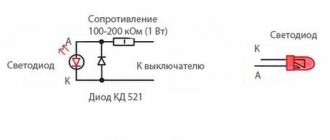SHARE ON SOCIAL NETWORKS
FacebookTwitterOkGoogle+PinterestVk
A well-chosen lighting design can change for the better not only the interior, but also your mood, giving you a feeling of comfort and inner warmth. For ideal lighting, both the design of the luminaires and the correct use of light sources are important. To figure out how to choose LED lamps for your home, you need to familiarize yourself with the parameters that distinguish them from other analogues.
LED lamps have low energy consumption compared to other types of lighting devices
Review of the main characteristics of LED lamps for the home
Many consumers, before buying LED lamps for their home, ask themselves: what are the fundamental differences between different types of lamps and what are the advantages of LED light sources? In this regard, the main technical properties of LED lamps should be noted:
- low power consumption;
- long functional life;
- no “strobe effect” - LED lamps produce a uniform glow that does not tire the eyes;
High environmental friendliness is one of the main advantages of LED lamps
- high luminous efficiency;
- the ability to glow in all shades of the rainbow spectrum;
- safety of use - the lamps are environmentally friendly, do not emit harmful substances or radiation, hardly heat up and are fireproof;
- ability to operate during voltage surges - if the network voltage decreases, the lamps will operate with lower brightness;
- versatility - due to the presence of standard sockets in the design, LED lamps can be used in previously installed lamps;
- optimal price-quality ratio - manufacturers of LED products are constantly working to improve technical qualities, while the price of products decreases every year.
These properties generalize all LED light sources. However, there are differences between LED lamp models. This applies to the size of the case, the type of base, the power of the device and many other parameters. Having understood the main characteristics of LED products, we can conclude which LED lamps are best for the home.
For ideal lighting, not only the design of the lamps is important, but also the correct choice of lamp type
Main types of LED equipment: determining the best
Under the name LED lamps, several types are combined, which differ in design:
- light sources with a completely transparent or slightly frosted cap;
- lamps resembling corn cobs are an outdated type of lighting device;
- filament models - sources on LED filaments (outwardly they resemble incandescent lamps and provide a maximum lighting angle).
The latter type of lighting equipment is most in demand. Filament models are used to produce radiation that closely resembles lighting from traditional incandescent lamps. Such equipment provides more than 100 Lm/W. The only drawback of these light sources is their shorter service life compared to other types of LED lamps.
LED lamps for 220V: circuits, device
The design of the LED lamp includes the following elements:
- diffuser - to increase the angle and distribute light evenly. Typically made of translucent plastic or durable polycarbonate;
- LED system - the number of LEDs used in the lamp determines its power, size and design. One lamp can use from one to several dozen diodes;
- aluminum printed circuit board - ensures heat removal from the LEDs to the cooling radiator;
- radiator - made of several aluminum plates. Removes heat from the printed circuit board;
- capacitor - an element of the adapter that serves to eliminate the effect of voltage ripple at the output;
- driver - used to convert alternating current. It rectifies and stabilizes the voltage to power the diodes;
- base of the plinth - made of polymer, it protects the housing from electrical breakdown;
- brass base - ensures contact with the lamp socket.
LED lamp device
Thus, the LED lamp is a block of diodes and a resistor power supply circuit that limits the current. The 220V LED lamp circuit represents the sequence in which the 220V mains voltage is supplied to the bridge rectifier element through the current limiting capacitor, designated C1 in the diagram, and resistor R2.
As a result, the LED system HL1 is supplied with constant power passing through resistor R4. The LEDs in the lamp begin to glow. The purpose of capacitor C2 in the circuit is to obtain a smoothed rectified voltage. Discharge of capacitor C1 when the LED light source is disconnected from the supply voltage occurs through resistor R1.
Power to size ratio
When deciding which lamp to choose for a particular lamp, remember that the higher the power of the lamp, the heavier and larger it is. All LED lamps are equipped with a cooling radiator, which is necessary for high-quality heat removal - otherwise it will overheat and fail faster. The larger the lamp, the larger its radiator, and the material from which it is made largely depends on its size and weight.
For example, light bulbs with aluminum radiators are always somewhat lighter (but also more expensive), while a glass radiator makes them much cheaper, but heavier and bulkier. In addition, glass heat sinks are not used for high-power lamps, as they have limited thermal conductivity - but some are aware of this fact, so the buyer should be wary.
How to choose LED lamps for your home: comparative analysis of light sources
The high cost of LED light sources often causes doubts about the advisability of using LED lighting. You can figure this out by performing a comparative analysis of an LED lamp and an incandescent lamp. Correspondence tables for various lamp characteristics give an idea of the return on investment of LED devices.
LED lamp wiring diagram
Types of LED lamp bases
For ease of use of LED products in a home network, devices are available with various options for standard sockets. This allows you to effortlessly replace old lamps with modern LED lighting sources. Main types of bases:
- E 14, E 27 - LED lamps with this base are quite common among consumers. The numbers indicate the diameter of the base (mm), the base itself has a screw connection system. Elongated bulbs with an E 14 base are usually used for small lamps, wall sconces and floor lamps. The price of LED lamps with E27, E 14 base depends on their power and the presence of a dimming function;
- GU 10 - the design of the rotary base is a two-pin connector with which the lamp is fixed to the socket. The connectors have thickenings at the ends, as evidenced by the “U” symbol in the designation of electrical accessories. The distance between the pins of such a clamp is 10 mm. Used in recessed ceiling lights;
- GU 5.3 - the distance between the pins in this base is 5.3 mm. Unlike the GU 10, the pins of this lamp holder do not have thickenings. The main application is for spot lighting lamps for suspended plasterboard ceilings;
Main types of LED lamp bases, their designation and purpose
- G 13 - this type of socket is used as a holder for lamps of type ST 8. The gap between the pin rods of the connector is 13 mm. LED lamps with this base are used for linear and ceiling lamps in places where it is necessary to illuminate an area of significant size (supermarket halls, warehouses, etc.).
Helpful advice! LED lamps with a socket with a pin connector should only be used in sockets with an appropriate pin spacing.
When choosing LED lamps by base type, you should give preference to those options that are used in lamps already installed in your home. If a floor lamp or chandelier has standard lamp sockets with a threaded quick connection system, then the lamp must also be selected with an identical holder.
Indicators of the power ratio of LED lamps and incandescent lamps
Until recently, when incandescent lamps were used for lighting, its level was assessed by power consumption. And if it was necessary to illuminate a large room, for example, a living room or hall, then a 100 W incandescent lamp was required. In the case of LED light sources, this criterion is somewhat incorrect, since they have different light output. When using LED lamps, some of the power is lost at the adapter.
A distinctive feature of LED lamps is their long service life
Thus, the power consumption value does not always indicate the corresponding brightness of the glow. When comparing the power of LED lamps and incandescent lamps, a factor of 8 is used. For example, to obtain the level of illumination that a conventional 60 W incandescent lamp provides, you will need an LED analogue with a power of at least 7.5 W, and a 200 W incandescent lamp can be replaced with an LED device 30 W.
For convenience, we provide data on the correspondence between the power of LED lamps and incandescent lamps. It should be noted that the indicators in the tables have average values, however, even with appropriate adjustments, you can see the advantages of LED light sources.
Table of the ratio of LED lamps and incandescent lamps by power:
| Types of light sources | Power, W | ||||||
| Incandescent lamp | 20 | 40 | 60 | 75 | 100 | 150 | 200 |
| LED lamp | 2 | 4 | 7 | 10 | 12 | 17 | 25-30 |
Table of correspondence of watts of LED lamps to incandescent lamps and fluorescent devices:
| Types of light sources | Power, W | ||||||
| Incandescent lamp | 20 | 40 | 60 | 75 | 100 | 150 | 200 |
| LED lamp | 2 | 4 | 7 | 10 | 12 | 17 | 25-30 |
| Fluorescent Lamp | 6 | 8 | 12 | 15 | 20 | 45 | 70 |
Correspondence of incandescent lamps to LED lamps in terms of light output
The choice of LED products is impossible without taking into account the ratio of incandescent lamps and LED lamps in terms of luminous flux. The unit of measurement for luminous flux is lumen. Not all manufacturers indicate this characteristic on the product packaging. In view of this, many consumers are forced to navigate based on power consumption. But if this parameter is still specified, choosing a product will not be difficult.
Considering that the average luminous flux of an incandescent lamp is 15 lm/W, a 60 W lamp will have a light output of 900 lm (60 x 15). The luminous flux of the LED lamp is about 90 lm/W. Multiplying the power of the device 11 W by 90 lm/W, we get 990 lm. Therefore, to obtain identical brightness when replacing a 60 W incandescent lamp, you can use an 11 W LED lamp.
LED lamps are significantly superior to incandescent lamps in many respects
Helpful advice! When organizing lighting in an apartment or house, LED lamps with a power of 6-10 W will be quite sufficient. Such devices will produce a luminous flux similar to the brightness of the glow when using 60 W incandescent lamps.
Often, the packaging of an LED lamp indicates that its brightness matches that of an incandescent lamp. You can also use a comparison of incandescent lamps, energy-saving and LED light sources in terms of luminous flux.
Correspondence table between LED lamps and incandescent lamps in terms of luminous flux:
| Incandescent lamp | Fluorescent Lamp | LED lamp | |||
| Power, W | Luminous flux, lm | Power, W | Luminous flux, lm | Power, W | Luminous flux, lm |
| 15 | 135 | 5 | 145 | 3 | 360 |
| 25 | 230 | 7 | 250 | 4 | 480 |
| 40 | 430 | 9 | 320 | 5 | 600 |
| 60 | 730 | 11 | 500 | 6 | 630 |
| 75 | 950 | 15 | 875 | 7 | 720 |
| 100 | 1380 | 21 | 900 | 10 | 920 |
Thus, when comparing incandescent lamps and LED lamps, you can see that the more powerful the device, the higher the luminous flux of any type of lamp. However, to obtain the required brightness, you can use an LED lamp with a much lower power, the energy consumption of which is 8 times lower than that of an incandescent lamp and 3 times lower than that of a fluorescent lamp.
Color temperature of LED lamps: choosing the optimal option
Unlike incandescent lamps, which produce a warm yellowish glow at any wattage, LED light sources can emit light of various shades. This is explained by the fact that the emission spectrum of an LED lamp has a varied color temperature, which is provided by two contained spectra: blue from the diode and spectrum from the phosphor - the substance that fills the lamp. When mixed, these two components produce a white glow of different shades.
When choosing LED lamps, you need to consider the color temperature
Thus, when purchasing LED lamps, you need to pay attention to the color of the device. Its value is expressed by the temperature in degrees Kelvin (K). To convert degrees Kelvin to the Celsius scale, you need to subtract the number 273 from their value, since the zero Kelvin mark corresponds to 273°C.
Like other parameters, the color of the glow is indicated by manufacturers in the technical documentation or on the packaging of the lamps. The designation includes a four-digit number and the letter “K”. A lamp that produces a warm white glow when illuminated will have the designation 2700 K, which is identical to the color of the luminous flux of an incandescent lamp. The color of the neutral (daytime) white glow is similar to the emission of a fluorescent light source and is designated 5000 K.
The hue of a diode lamp can range from warm white to cool white, and lamps of this type hardly heat up during use.
The main feature of LED lamps is that they can reach a glow temperature of up to 7000 K and still barely heat up. This indicates that all their energy is converted into a useful glow. The color of the emitted light can range from warm yellow to cool white.
Helpful advice! When decorating the lighting of rooms where elderly people will be, preference should be given to lamps with a neutral white glow. This will help older family members correctly perceive the colors of objects.
LED Beam Angle
Previously, when purchasing conventional lamps, the question did not arise about what the luminous angle of this light source was. The fact is that incandescent lamps emit light equally in all directions. The luminous flux angle of LED lamps can be different. And this should be taken into account when choosing products.
The radiation angle of LED lamps can be different, which is also an important selection criterion
If you use LED lamps with a narrow beam in a ceiling chandelier, then, depending on its design, only the place on the ceiling above it or on the floor below it will be illuminated. In this case, the main lighting will not correspond to its functions and the room will be dim.
A table will help you select lamps with the required luminous flux angle, which indicates the scattering angle of different lamp models and the designation corresponding to this value. As a rule, this parameter is also specified by the manufacturer on the device packaging.
Table showing the scattering angle of lamps of different models:
| Scattering Angle (degrees) | Technical designation | Lamp illumination |
| < 8 | VNSP | Quite a narrow beam of light |
| from 8 to 15 | NSP | Limited spot |
| from 15 to 20 | SP | Small spot |
| from 24 to 30 | NFL | Narrow flow |
| from 35 to 40 | FL | Small flow |
| from 55 to 60 | W.F.L. | Even distribution of light |
| over 60 | VWFL | Wide luminous flux |
When choosing the scattering angle of LED lamps, it is necessary to take into account the purpose of the lighting for which they will be used. Lamps with narrow beam radiation are suitable for accent lighting of furniture, decor and small areas of the interior. Such devices are also recommended for use in LED table lamps for the desktop.
Functions of a radiator in the design of a LED lamp
To remove heat, the design of the LED lamp includes a radiator. This is done so that when heated strongly, the diode crystal does not lose its light output property. In addition, overheating reduces the lifespan of LEDs. The radiator itself is located inside between the base and the lamp body.
Radiator for LED lamp EcoLamp
Radiators made of plastic, covered with a shiny film, are not able to fully remove heat and ensure the safety of the diode. But the radiator is not visible to the buyer purchasing the lamp. In some cases, you can use a simple technique: lightly tap the outer surface of the radiator with a small metal object and determine by the characteristic sound what it is made of.
Modern LED lamps have a heatsink made of aluminum or its alloys. The design of such radiators has a spiral arrangement of fins that have different lengths. This shape ensures good air circulation and high-quality heat dissipation. You can navigate the design of the radiator based on the cost of the product itself. The likelihood that you can buy an LED lamp at a low price with a high-quality radiator is very small.
Different types of LED lamps
Types of LED lamps by form and functionality
LED lamps come in a variety of shapes and sizes. All lamps with a pin connector are the same in shape. As for the threaded connector, lamps with such a base can have many designs:
- The pear shape is the standard lamp shape and occupies the first position in the ranking of LED lamps for the home. Used in dimensional lampshades. Has a height of 106 to 126 mm and a width of 60 mm;
- spherical shape - such models are mainly used in small round lampshades;
- candle shape - usually has a “minion” type base and is used for narrow and flat lamps;
- the shape of a candle in the wind is a creatively shaped lamp, usually with a dimming function, which provides an incredibly beautiful play of crystals;
- reflector lamp - used to create directional lighting in spotlights;
- corn - the bulb of such a lamp is similar to an ear of corn.
LED lamps differ not only in shape, but also in functionality
Helpful advice! In corn lamps, the outer contacts of the diodes are energized. In view of this, they should be installed in a protective shade.
LED lamps can differ not only in shape and size, but also in internal content. Depending on functionality, lamps may have:
- pulse drivers on microcircuits;
- RGB LEDs - these bulbs can emit all the colors of the rainbow;
- remote control - brightness changes are carried out via radio from the remote control;
- built-in power supply battery - offline operation;
- control system via Wi-Fi.
There are special models of lamps that are not intended for use on a home network. These include 12 volt E27 LED lamps. The main application of these light sources is emergency lighting, lighting of industrial workplaces, building envelopes, etc. The low supply voltage ensures safety for people in the workplace.
Ecola lamp driver (G4AW54ELC) E14
The use of LED lamps 12 volt E27 base is also suitable for energy-independent systems of private cottages, yachts, and boats. Such lamps provide stable brightness of a neutral white shade. Devices are connected to a 220 V network via a transformer for 12 volt LED lamps.
Scattering angle
Important characteristic. Without it, it will be difficult to realize the design concept. What lighting fixtures will help highlight a single detail of the interior, or fill the entire room? It's simple:
- The light emitted with a scattering angle of 120º is very weak and unfocused.
- The light emitted with a scattering angle of 30º is maximally directional. It is capable of performing its tasks even from great heights.
The conclusion is this : the smaller the angle, the higher the concentration of rays.
For ceiling lighting, it is better to use lamps with a small angle of 30 ° - 40 °. To highlight small shelves and niches, devices with an angle of 60 ° are suitable. 40 and 60 incandescent lamps 120 LED sources .
Standards for illumination of a schoolchild's desk
Due to the fact that a child’s vision at school age is in the process of formation and improvement, it is especially important to choose the right lighting for the desktop at which he will study. To do this, it is necessary to take into account not only the location of the table and lamp, but also choose the right lamp model.
Illumination standards
There are lighting standards for both different rooms and their individual zones. It goes without saying that the most favorable for the human eye (including the child’s eye) is daylight. However, given that the child is in class, homework often has to be done at a time when there is no longer enough natural light.
When choosing a table lamp model for a child, you must first of all be guided by the maximum comfort of the device and its safety.
Desktop lighting standards require light output to be smooth, soft, flicker-free, shadow-free, and within 300 lux. Lux is a unit of illumination created by a light flux of 1 lm distributed over a surface of 1 m². To measure the level of illumination, a special device is used - a lux meter.
If the child has a separate room, care must be taken to ensure that the curtains in the room let in as much light as possible and that the window is not cluttered with foreign objects. In addition to local lighting of the desk, it is necessary to use the main light in the room where the student studies. This will avoid eye strain and fatigue.
Selecting a table lamp model
When choosing a table lamp model, you must be guided by the maximum comfort of the device and its safety. The line of this product includes dozens of models. For convenience, table lamps have a flexible holder, which allows them to be quite mobile within the table. As an option, you can use a lamp with a clothespin mount, which rigidly fixes the lamp to the surface. The use of such models eliminates the risk of accidental falls.
LED lamps produce a uniform glow that does not tire the eyes
Helpful advice! The shade of an LED table lamp for a schoolchild should completely cover the light source so that the direct light flux does not hurt the eyes.
Which is better: LED or energy-saving lamp? Regarding the light sources used in table lamps, experts recommend the use of LED lamps. They emit a pleasant, uniform light without pulsating, do not burst, do not emit harmful substances and have a minimum heating temperature. The lamp power should be selected so that the light is not too saturated and not too dim.
Today, models of table LED lamps with a brightness control have appeared on sale. Such devices have several levels of illumination and touch control of the glow. Using a dimmer, you can adjust the brightness to the desired comfortable level. Dimmable lamps are the latest development in the field of lighting technology.
For table lamps, it is recommended to use LED lamps, the light of which is as close as possible to natural daylight.
Brightness
This characteristic is determined by the luminous flux produced by the lamp in normal mode. Luminous flux is measured in lumens (lm). The higher this parameter, the more space the light bulb can illuminate with high quality. At the same time, as brightness increases, energy consumption and the price of the lamp itself increase. Yes, and very bright light has a negative effect on the eyes and causes fatigue.
Power to brightness ratio.
Incandescent lamp:
- 20 W – 250 lm;
- 40 W – 400 lm;
- 60 W – 700 lm;
- 75 W – 900 lm;
- 100 W – 1200 lm;
- 150 W – 1800 lm;
- 200 W – 2500 lm.
Fluorescent Lamp:
- 5-7 W – 250 lm;
- 10-13 W – 400 lm;
- 15-16 W – 700 lm;
- 18-20 W – 900 lm;
- 25-30 W – 1200 lm;
- 40-50 W – 1800 lm;
- 60-80 W – 2500 lm.
LED lamp:
- 2-3 W – 250 lm;
- 4-5 W – 400 lm;
- 8-10 W – 700 lm;
- 10-12 W – 900 lm;
- 12-15 W – 1200 lm;
- 18-20 W – 1800 lm;
- 25-30 W – 2500 lm.
Why LED lamps blink: causes and solutions
Some consumers, having installed LED lamps in their home, notice that their operation is accompanied by flickering. Such lighting tires the eyes and harms vision in general. Having understood the reasons for this negative effect, you can find ways to eliminate it.
Why do LED lights blink when turned on?
There are several known reasons why LED lamps blink when turned on. Why is this happening:
- incorrect installation - it is necessary to check all the contacts of the circuit, they must be strong;
- the power of the adapter does not match the lamp used - you can replace the power supply with a new one that matches the power;
- significant voltage surges - the driver may not be able to cope with surges whose level is beyond the permissible limits;
LED lamps can operate without problems during power surges
- defective product during production - it is necessary to replace the light bulb, since this product is accompanied by a warranty;
- backlit switch - it is not recommended to use such switches in conjunction with an LED light source, since when such a device is turned off, the circuit is in a closed state and contributes to the glare of the lamp;
- mismatch of wire connections - the “zero” phase should be output to the lighting device, and the wire with the phase should be output to the switch;
- the presence of household electrical appliances that create high-frequency interference;
- The LED lamp has expired.
But many people also encounter another problem when LED lamps glow after being turned off. You can find out why this happens by familiarizing yourself with the functional features of LED lamps.
Why do LED bulbs flicker or glow when the lights are off?
The reason why the LED lamp lights up when the switch is off or flickers periodically may be due to the LED backlit switch. If you replace the backlit device with a regular switch, the lamp should stop flashing.
Spectrum of different light sources
The fact is that when the electrical installation device is turned off, it does not completely open the circuit: the main supply of electricity stops, and the backlight LED closes the circuit to itself. The current passing through the diode charges the capacitor of the LED lamp driver, causing it to either blink or produce a dim light.
Another reason why an LED lamp burns when the light is off is a low-quality product. If you purchased an LED lamp at a low price and its manufacturer is unknown, the device probably contains low-power components. Light sources offered by leading manufacturing companies usually use capacitive capacitors. Of course, their cost is high, but they do not blink even when paired with an LED backlit switch.
Why do LED lamps burn out?
The main reasons for the failure of LED light sources are poor quality products or external influences. The latter include:
- a significant excess of the supply voltage - if there are voltage surges in the electrical network, preference should be given to models designed for 240V or more. You can also resort to using protective blocks and rectifiers;
To avoid problems, it is best to choose products from trusted manufacturers
- low-quality lamp sockets - low-quality material of the sockets tends to collapse when overheated, the contacts oxidize, thereby creating even greater heating of the LED lamp base;
- the use of powerful lamps in closed-type lampshades not intended for the use of powerful light sources;
- using the mode of frequently turning on and off LED lamps - the working life of the lamps is noticeably reduced;
- incorrect connection diagram - if one lamp fails, the fault is transmitted to other light sources in the common circuit;
- poor-quality connection of wires at nodal points of the electrical network - when connecting, it is recommended to use terminals, soldering or other modern connection options.
Every year the price of LED lamps becomes lower and lower
Helpful advice! For LED lighting, use lamp models with remote power supplies. In the event of a malfunction, they can be accessed for repair or maintenance.
Shape selection
LED lamps have replaced their tungsten “ancestors” and are actively taking their place even in old crystal chandeliers left over from grandmothers. Therefore, the shapes of the representatives of the LED family have remained traditional.
For spotlights, try using a PAR (parabolic reflector) or BR (reflective ball). Tracks and built-ins work well with the R (mirror lamp) shape. C (candle) looks decent in chandeliers
LED lamps for the home: product prices
After familiarizing yourself with the main characteristics of LED light sources, it becomes clear which lamps are better. Although LED products have a high price, their undeniable technical advantages set them apart from other devices.
You can purchase lamps by ordering products in online stores, on the websites of manufacturing companies, as well as in lighting equipment stores. The cost of an LED lamp for a home with an E 27 base similar to a 100 W incandescent lamp is from 225 rubles. and higher. The price of an LED lamp with an E14 base (minion type) varies from 96 rubles. up to 750 rub. per piece depending on the power of the device.
In corn-type lamps, the outer contacts of the diodes are energized, as a result of which they should be installed in a protective shade
Almost all products purchased from official representatives are covered by a manufacturer's warranty. The warranty period can range from 2 to 5 years. In addition, any of the purchased LED lamps can be exchanged for a more suitable model or a refund can be issued within a period not exceeding 14 days from the date of purchase.
Helpful advice! To ensure that there are no questions when returning LED products, it is recommended to save the product packaging.
Products from well-known and trusted manufacturers will differ significantly in price from LED products from dubious companies, which will last a few months at most. And the quality of the LEDs used in such lamps leaves much to be desired: the actual light output of such sources is much worse than the declared parameters.
With the help of modern diode lamps you can achieve truly comfortable and harmonious indoor lighting
Mass production of LED products is growing every year. In this regard, a cost reduction of approximately 25-30% is predicted. Nevertheless, the payback of LED lamps is possible even if they are purchased at current prices.
Types of socles
All LED lamps operating on voltages of 12 Volts and 220 Volts differ in the size and shape of the base. E27 (standard), E14 (minion) are the most common modifications, which are equipped with an Edison base. E40 are light sources characterized by a “Goliath” base and are used for industrial and street lighting. G4/GU4, and also represent miniature varieties of LED equipment, characterized by pin mounting. Such microlamps are used in interiors, in the manufacture of furniture and other structures created by designers.
G5.3/GU5.3 is a designation used for sockets, also characterized by pin fastening and intended for decorative use. G53/GX53 are two types of base that are not very common and are intended for use with cardan and ceiling mounting. G13, G10/GU10 are characterized by arm mounting and are most often used for accent and ceiling lighting. Lamps with S14s socket are most often used for interior lighting in residential buildings and commercial properties.
Lighting equipment of all types can operate on voltages of 220 V and 12 V. 12-volt equipment cannot be connected directly to the network. Such light sources must be used in conjunction with a step-down transformer. As a rule, such lamps are used to illuminate furniture and other structures. Light sources that operate on 220 Volts can be connected directly. They are designed to create basic lighting.
Functions
Brightness adjustment - makes it possible to change the brightness of the light bulb using dimmers that change the operating voltage. This feature is most often used in incandescent lamps, while other types of lamps are not always compatible with dimmers.
Fluorescent and LED models require special dimmers. The disadvantage of this option is the dependence on an external device (dimmer). In modern RGB LED models, brightness adjustment is carried out using a built-in regulator - in this case, an external dimmer is not needed.
Important: the ability to adjust brightness (dimmer compatibility) is indicated in the characteristics of halogen, fluorescent, and LED lamps.
Color control – allows you to select the color of the RGB LED lamp or strip.
Scenario/schedule support – allows you to configure the lamp to operate according to a specific lighting scenario (template)/schedule. Scenarios differ from each other in brightness and color temperature of light; they can be static or dynamic. The schedule makes it possible to control the time the light bulb turns on and off, and set operating modes at certain times.
Principle of operation
To understand the convenience of using all these quantities, we need to consider the direction of LED emission, and related concepts.
Angles of LED illumination with lens
The design of the light-emitting diode is such that it does not send light evenly in all directions - the lower hemisphere is covered by a substrate, and the design of the lens is such that it does not provide uniform radiation in the upper hemisphere. As a result, the main light flux is concentrated in the upper direction and weakens towards the periphery of the light cone. At a certain viewing angle, the intensity of the glow is reduced by half, and when an even greater angle is reached, the light becomes invisible. The first angle (bac) is called the half brightness angle, and the second (fah) is called the full brightness angle.
Luminous angles of an LED with phosphor
The same points apply to an LED with a phosphor. There, the radiation angle is limited by the substrate and the angle of greatest activity of the initiating radiation of the pn junction. You must understand that it is impossible to accurately determine these angles by eye - special instruments are needed. But you can visually compare two LEDs - which one has a larger opening angle.
Luminous flux of outdoor lighting
To calculate outdoor lighting, one must proceed from the minimum illumination standards, which can also be found in the relevant SNiP (SP). So, for children's playgrounds, the minimum illumination should not be less than 10 lux.
The standards give minimum illumination values; they can be increased during calculations.
To obtain the required number of lamps (N) to obtain the required illumination, you need to set the initial data:
- minimum illumination (E), lux;
- area (S), sq.m.;
- illumination unevenness coefficient (z), for LED lamps it is equal to 1.2;
- a multiplier that takes into account the weakening of the luminous flux at the end of the lamp's service life (k), for LED devices it is equal to 1.2;
- luminous flux of one lamp (F), lm;
- the coefficient for taking into account the reflection of objects located nearby (n), for asphalt it can be taken as 0.3.
These quantities are related by the formula N=E*S*z*k/(F*n).
Playground lighting
Suppose you need to illuminate a children's playground with an area of 150 sq.m. There are lamps emitting a luminous flux of 1500 lm each. Substituting the values into the formula, we get N=10*150*1.2*1.2/(1500*0.3). You will get 4,8 or 5 lamps. This is the minimum quantity; in fact, more can be installed.
You can ask not the luminous flux of the existing lamps, but the number of lamps that can be installed on the territory. In this case, it is necessary to calculate the luminous flux of each lamp. The calculation formula will take the form F=E*S*k*z/(N*n). If the final result does not fall into the standard range of lamp characteristics, it must be rounded up.
Manufacturer
Products in the mid-price segment and below consist of light bulbs from little-known manufacturers and other low-quality brands: Saturn, Electrum, Foton, and Global. Their main disadvantages are the discrepancy between the power of the light flux and the declared one, unreliable operation (they often burn out quickly), and not the best quality bases.
Excellent quality is provided by the brands Brille, Delux, Maxus, Panasonic, Philips, Eurolamp, Osram, Economka, Verbatim. It is worth noting that these brands have different “strengths”. For example, the best LED lamps are made by Philips, Osram, Maxus and Verbatim. They are the most economical and reliable. And among fluorescent lamps, the Maxus brand gives up its leading position to the Economy brand. And almost every type of light bulb has its own leading manufacturer. It is necessary to study comparative tests and reviews carefully and in detail.
Remote control
Wi-Fi – allows you to control the settings of the “smart lamp” from anywhere in the world.
Bluetooth – makes it possible to work with a “smart lamp” from a relatively close distance.
Remote control – allows you to control the light bulb from a distance. Such a device is usually found in RGB LED lamps with brightness adjustments or color settings.
Important: when choosing a lamp, be sure to check its serviceability. To diagnose a light bulb, testers with light or sound indication are used.
Life time
Manufacturers indicate lamp life under ideal conditions. Practice shows that this parameter is influenced by the build quality of the lighting device, the stability of the rated voltage, the quality of wire switching, humidity and ambient temperature and some other factors.
- incandescent lamp - 1000 hours (six months), some lamps have a longer life - 3000 hours;
- halogen lamp – 2000-4000 hours;
- fluorescent lamp - 15,000-20,000 hours;
- LED lamp – 50,000 hours.

